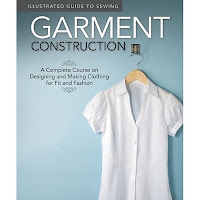You have to love those guys at Amazon. Their targeted marketing is dead on. By now, Amazon knows I'll buy almost any sewing book. Every time I visit the Amazon site, I'm tempted with sewing books. At the top of every page I see, "Hello. We've got recommendations for you". Click the link, and I've got about 50 sewing titles to browse through (
many of which I already own). I also get tempting emails. Recently, Amazon sent an email heralding new sewing books and that's how I learned about the
Illustrated Guide to Sewing series. I'm glad Amazon knows me so well. I really like my two newest books.
Lately, any book with the word
"couture" in the title interests me. I am on a mission to upgrade my skills and incorporate couture techniques into my sewing. In the absence of classes, what better way to learn something than to buy books on the topic. I like this book much better than the
last book I bought on couture techniques. It's not a book for beginners or sewers looking for quick techniques. There are only three chapters in this book: Premium Fabrics, Getting the Right Fit and Couture Techniques, but a lot of information is covered. The sections on fit are quite extensive and cover topics like dolman and raglan sleeves. The book recommends making a muslin and using standard "slash and fold" pattern fitting. The couture techniques chapter never mentions fusible interfacing! Can you believe it? Interfacing sewn in by hand! (
I guess real couturiers don't fuse.) And there is lots and lots of basting and thread tracing with illustrated instructions on several hand sewing stitches. And speaking of hand sewing stitches, the instructions for putting in a centered zipper involves very little machine sewing.
I also want to make a tailored garment. Since I was in a book buying mood, I also ordered this title. Somehow, making a tailored jacket scares the bejeezus out of me. I made a jacket a few years ago, but I've been afraid to wear it. The subtitle is "A Complete Course on Making a Professional Suit" and that is exactly what this book is. * I like this book because the sections on pattern fitting are not general fitting techniques but are specific to suit patterns. Men's and women's jackets are addressed separately. As in
Couture Techniques, no fusible interfacing is mentioned. The step-by-step instructions are very detailed, almost to the point of intimidation. There are
69 steps for constructing a flap pocket. But there are tons of multi-colored diagrams to help.
 |
| These diagrams show twill tape, pad stitching interfacing and lining, yet they are not confusing. |
Another title in this Illustrated Guide to Sewing series is
Garment Construction. Those evil marketers at Amazon offered special pricing for all three titles. I didn't order
Garment Construction, though. Not because of any strength of will, but because I felt confident in general garment construction and I already own four or five basic books. Besides, at the time I received the email, the book hadn't been released. But, judging from my reaction to
Couture Techniques and
Tailoring, there might be something new for me to learn from
Garment Construction and I may end up buying it, too. I wouldn't want to break up the set!
Amazon lists Peg Couch as the editor of this series although her name does not appear on the title page. She is described as "an amateur seamstress and book acquisition editor at Fox Chapel Publishing". At first, I was put off by the word "amateur". But the information is these book is far beyond "amateur". Both books remind me of the articles that used to appear in
Threads Magazine back in the 1980s. Right now the techniques seam beyond my skills. But now I have the information to improve my skills. That is exactly what I was looking for.
* I don't know if Peter of Male Pattern Boldness reads my blog. I believe he could sew the suit he promised Michael if he had this book.
 I've always been the kind of person who needs a plan. Since the P in SWAP stands for Plan, I believed I could finish a SWAP. Several days ago, my SWAP felt more like a SWAMP and I didn't know how to move on. I wasn't enjoying the project, but I still was compelled to finish it. The problem was I had no direction – no plan.
I've always been the kind of person who needs a plan. Since the P in SWAP stands for Plan, I believed I could finish a SWAP. Several days ago, my SWAP felt more like a SWAMP and I didn't know how to move on. I wasn't enjoying the project, but I still was compelled to finish it. The problem was I had no direction – no plan. 






